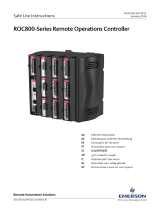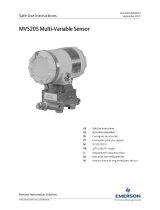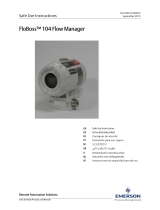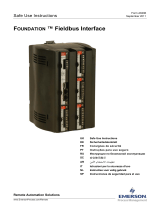
Anleitung zur sicheren Verwendung – ControlWave Micro
Dok.-Nr. D301761X012
Juni 2021
4 www.Emerson.com/RemoteAutomation
den Gerätebetrieb zu minimieren, und schützt vor
Überspannungen/Blitzschlag.
Basisgehäuse verfügen über eine Erdungsklemme (siehe
Abbildung 2), die Kabel mit einem Durchmesser bis zu
5,19 mm (4 AWG) aufnehmen kann. Nach Installation
des Basisgehäuses und allen Erweiterungsgehäusen und
vor der Installation von Modulen im Basis- oder
Erweiterungsgehäuse muss ein Erdungskabel zwischen
der Erdungsklemme des Basisgehäuses und einer
zuverlässigen Erdung verlegt werden. Bei allen Erdungen
darf die Impedanz des Stabs bzw. des Netzes zwischen
Erdung und Masse maximal 2,0 Ohm betragen,
gemessen mit einem Erdungsprüfgerät. Der Erdleiter
sollte einen Widerstand von maximal 1,0 Ohm zwischen
der Gehäusemasse des ControlWave Micro und dem
Erdungsstab oder Erdungsnetz aufweisen.
Hinweis: Nach der Installation des Stromversorgungs-
/Sequenziermoduls (PSSM) ein Kabel mit
einem Durchmesser von 1,63 mm (14 AWG)
vom Stromanschluss TB1-3 (Masse) zur
gleichen Erdung verlegen.
Wenn die Impedanz zwischen Leitung und Erdung
über 2 Ohm liegt, eine elektrische Isolierung am
ControlWave Micro anbringen und ein Erdungssystem
mit Erdungsstab oder -netz installieren.
Für die E/A-Signale wird ein isoliertes, abgeschirmtes,
verdrilltes Doppelkabel empfohlen. Durch die Verdrillung
und die Abschirmung werden Signalfehler durch EMS
(elektromagnetische Störung), RFI (Funkstörung) und
Transienten minimiert.
5. Das Stromversorgungs-/Sequenziermodul (PSSM)
installieren und konfigurieren. Genaue Anweisungen
zur Einrichtung des PSSM entsprechend den
Bedürfnissen Ihres Standorts finden Sie in der
Betriebsanleitung für den ControlWave Micro
Prozessautomatisierungs-Controller (ControlWave
Micro Process Automation Controller Instruction Manual)
(Dok.-Nr. D301392X012).
6. Die CPU, Kommunikations- und E/A-Module
installieren und konfigurieren. Genaue Anweisungen
zur Einrichtung dieser Module gemäß den
Bedürfnissen Ihres Standorts finden Sie in der
Betriebsanleitung für den ControlWave Micro
Prozessautomatisierungs-Controller (ControlWave
Micro Process Automation Controller Instruction Manual)
(Dok.-Nr. D301392X012).
7. Den ControlWave Micro mit dem Stromnetz, E/A-
Geräten und Kommunikationsgeräten verbinden. Die
externen Anschlüsse (oder Feldanschlüsse) befinden
sich alle an der Anschlussplatine. Die Klemmleiste ist
für einen Durchmesser bis zu 1,63 mm (14 AWG)
geeignet.
Die Anschlüsse des ControlWave Micro sind
Schraubklemmen. Der Anschluss für den
Eingangsstrom (IN+/IN–) verwendet einen
beweglichen Stecker und ist für Kabel mit einem
Durchmesser bis zu 1,63 mm (14 AWG) geeignet. Für
den Anschluss immer das Kabelende abisolieren
(maximal 6 mm), in die Klemme unter die
Klemmschraube einführen und die Schraube dann mit
einem Drehmoment von 0,25 Nm festziehen.
Um Kurzschlüsse zu vermeiden, sollten die Adern der
eingeführten Kabel so kurz wie möglich abisoliert sein.
Bei der Herstellung von Verbindungen auf
Zugentlastung achten.
Hinweise:
Achtung: Die Klemmenschrauben nicht zu fest
anziehen.
Vor dem Einschalten der Spannungsversorgung die
Polarität des Eingangsstroms prüfen.
8. Die Stromversorgung des ControlWave Micro
einschalten.
9. Um den ControlWave Micro in Betrieb zu nehmen, mit
der ControlWave Designer-Software ein ControlWave-
Projekt erstellen, das den Anforderungen der
jeweiligen Anwendung entspricht. Das Projekt in das
Gerät laden. Dann mit dem Dienstprogramm „Flash
Configuration“ die Konfigurationsparameter
einstellen.
Hinweis: Einen Überblick über diesen Vorgang und
Referenzen zu anderer relevanter
Dokumentation finden Sie in der
Kurzanleitung für den ControlWave Micro
(ControlWave Micro Quick Setup Guide)
(D301425X012).
10. Falls Probleme auftreten, deren Ursache in der
Hardware vermutet wird, die Verkabelung prüfen. Falls
die Probleme weiterhin bestehen, wenden Sie sich an
Ihr lokales Vertriebsbüro, um eine
Rückgabegenehmigung zu erhalten.
11. So nehmen Sie den ControlWave Micro aus dem
Betrieb:
Prüfen, dass der Bereich sicher ist.
Die Stromversorgung vom Gerät trennen.
Alle externen Kabelanschlüsse entfernen.
Den FB107 aus dem Gehäuse herausnehmen.
12. Den ControlWave Micro in einen geeigneten Behälter
für den Transport oder Versand legen.

























